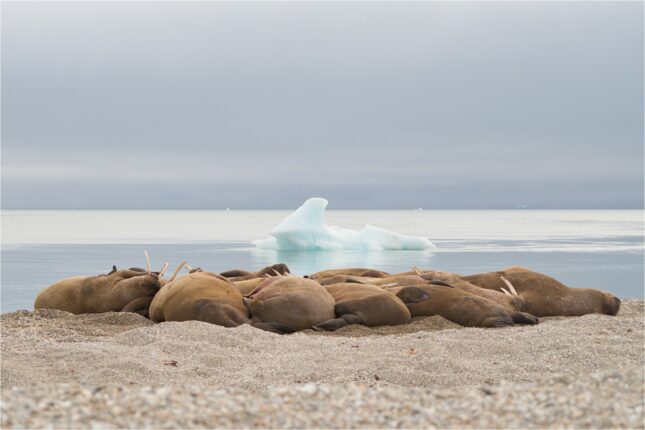-
The New Arctic: Amid Record Heat, Ecosystems Morph and Wildlife Struggle
March 1, 2024 By Sharon Guynup
This article, by Sharon Guynup, originally appeared on Mongabay.
Walruses have traversed the Arctic for millennia, gregarious pinnipeds that rest en masse on drifting pack ice, diving to feed on crabs, clams and other seafloor delicacies. Icy platforms also serve as safe birthing and nursery grounds. But as the far north rapidly warms and sea ice disappears, some herds now huddle on overcrowded shorelines, with deadly consequences for young calves: Because more disturbances occur on shore than at sea, calves are regularly trampled during panicked stampedes by the 1-ton-plus adults.
Climate-driven changes are affecting other wildlife across this land of snow and ice. On the Arctic tundra, lemmings now struggle to eat, nest and move during the eight winter months they live beneath the snow, as they endure “weather whiplash,” with ever more severe fluctuations in temperature, snow and rain, says ecologist Dorothee Ehrich, at the Climate Ecological Observatory for Arctic Tundra with Norway’s Arctic University.
As warming escalates, animals are on the move, bringing new diseases north. In December, officials reported that H5N1 avian flu infected and killed a polar bear — a global first. This highly infectious strain has circulated internationally since 2021, jumping between species, and has reached the polar region. It’s just one example of new pathogens there, raising serious concern because isolated Arctic species have little immunity to disease.
Researchers are witnessing dramatic shifts in the behavior and abundance of Arctic wildlife on land and sea — shifts coinciding with rapid warming and extreme weather. “The speed of change is really hard to comprehend,” says Kyle Joly, a biologist with the U.S. National Park Service. Both in the Arctic and around the globe, 2023 was by far the hottest year in recorded human history.
With global warming impacts highly magnified at the poles, “ecosystems are rearranging at every trophic level,” says Arctic climate and policy expert Joel Clement. “The Arctic is transforming into a warmer, wetter ecological state before our eyes.” Habitats are eroding as glaciers and sea ice recede, coastlines submerge, and permafrost thaws. Bays that were frozen year-round are dotted with bobbing blue ice floes — or have become open sea.
Radical shifts in weather and temperature reverberate across these ecosystems, making it harder to find food, and increasing pressure from competitors invading from the south. No plant or animal is exempt, from the microscopic plankton and crustaceans that fuel the entire Arctic food web, to the region’s iconic belugas and polar bears, or the 200 or so migratory bird species that breed in the Arctic.
A disturbing question looms: Can these animals evolve quickly enough to adapt to what Clement calls “a new geography of survival”?
Continue reading on Mongabay here.
Sharon Guynup is a Global Fellow with The Wilson Center’s Environmental Change and Security and China Environment Programs. She is also a National Geographic Explorer. Much of her work on environmental issues focuses on wildlife, ecosystems and the threats they face
Sources: Mongabay, NOAA, the Guardian, Climate.gov, The Lemelson Foundation, Arctic Council
Photo credit: Still life with walruses and iceberg, Flickr user Rob Oo, CC BY 2.0
 A Publication of the Stimson Center.
A Publication of the Stimson Center.



